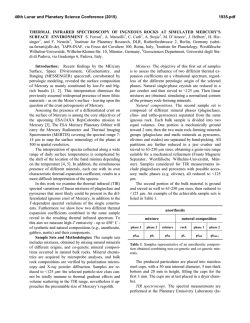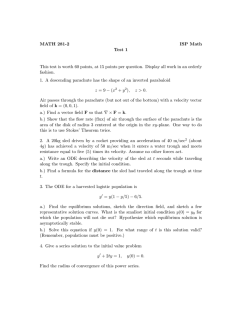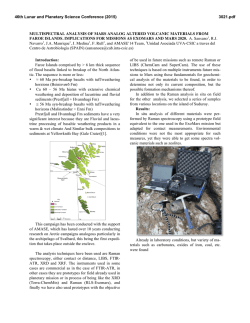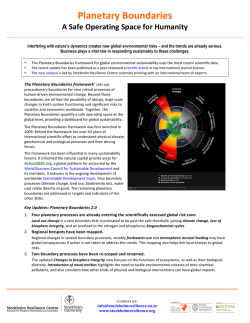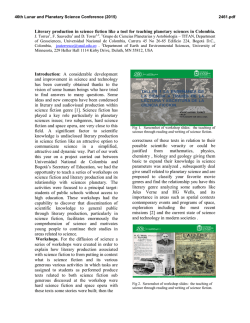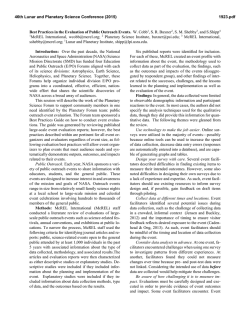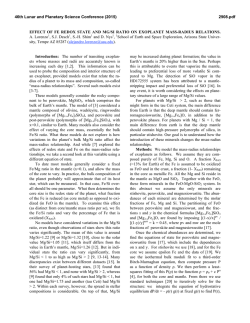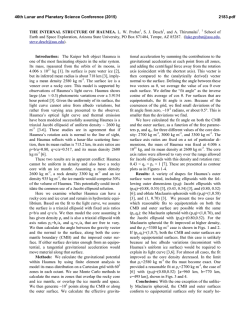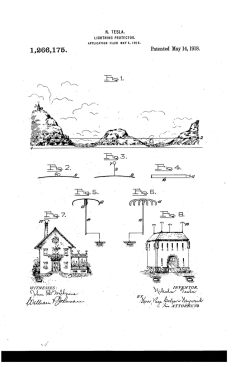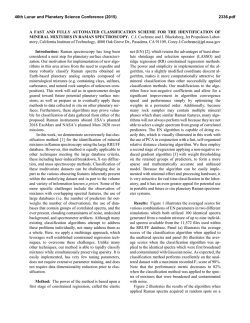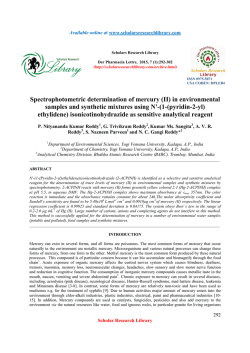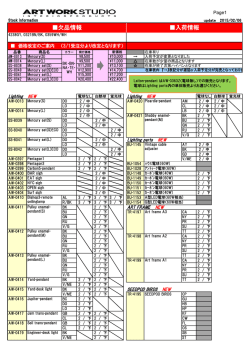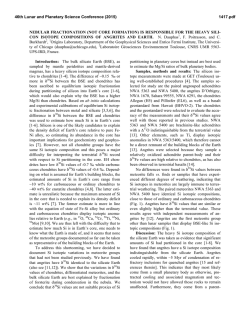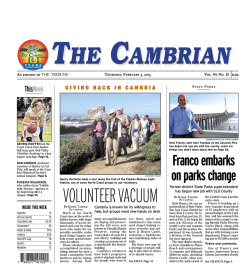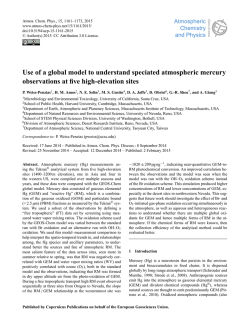
THE INTERNAL CONFIGURATION OF PLANET MERCURY. J. S.
46th Lunar and Planetary Science Conference (2015) 1345.pdf THE INTERNAL CONFIGURATION OF PLANET MERCURY. J. S. Knibbe1 and W. van Westrenen1, 1 Faculty of Earth and Life Sciences, VU University Amsterdam, De Boelelaan 1085, 1081 HV Amsterdam, the Netherlands, [email protected]. Introduction: The determination of Mercury’s moment of inertia (C/MR2) of 0.346 ± 0.014 and the fraction of polar moment induced by the outer solid shell (Cm/C) of 0.431 ± 0.025 ([2] and [4]) has enabled modelling studies to constrain the location of the coremantle boundary (CMB) to 2020 ± 70 km in radius ([1] and [3]) assuming a core composition of binary ironsulfur or iron-silicon alloys, possibly overlain by a solid FeS-layer. The present-day radius of the inner core, however, is poorly constrained. In this study we reexamine the implications of proposed interior configurations for Mercury and attempt to constrain the present-day inner core radius using recently improved estimates for Mercury’s planetary contraction of up to 7 km in radius [5], assumed to be the consequence of planetary cooling and, in particular, core solidification. Method: A large set of density profiles for Mercury have been generated in a Monte-Carlo approach similar to Hauck et al. [1] corresponding to the interior configurations describe above with the mantle’s average density, light element content of the core, CMB radius, inner core boundary (ICB) radius and CMB temperature as varying parameters. For each of these profiles, the planetary contraction due to core solidification (ΔRcs) up to the ICB is calculated based on the density difference between molten and solid core material according to their respective equations of state. Generated profiles are constrained by Mercury’s total mass, the known C/MR2 and Cm/C and an upper limit of 7 km for planetary radius contraction (ΔRcs). Results: The CMB radius is constrained to 2005 ± 60 km for configurations without a solid FeSlayer. With an FeS-layer, the outer liquid core boundary (OLB) is located at 2004 ± 40 km, with a CMB radius ranging up to a maximum value of 2162 km. The pressure at the CMB, or OLB for models with a solid FeS-layer, is around 5.25 ± 0.3 GPa without an FeSlayer and around 5.5 ± 0.5 GPa with a FeS-layer. The CMB radius correlates strongly with light element content of the core and the average density of the outer solid shell. In general, a higher average mantle density requires more light elements to accompany iron in the core. The ICB significantly affects C/MR2 and Cm/C only in the iron- sulfur core models, because sulfur’s preferential partitioning into liquids generates a large density jump at this boundary, whereas silicon’s nonpreferential liquid/solid partitioning doesn’t. Variations in CMB temperature, that account solely for thermal expansion in our model analysis, are unconstrained. Figure 1: The residual squared error (ERSS) with respect to the known C/MR2 and Cm/C ([2]), plotted against the CMB radius for the generated density profiles of the binary inro-silicon (a) and the iron-sulfur (b) core alloys without an FeS-layer. The colorbar denotes the light element content in the core. The solid and dashed lines denote ERSS = 1 and ERSS = 2, respectively. However, relating liquid-solid phase equilibria at the ICB adiabatically to the CMB temperature suggests that a temperature of 2050 °C at the CMB represents an upper temperature limit for the occurrence of a pure iron solid inner core. Cores of iron-silicon and ironsulfur alloy yield a lower limit for the CMB temperature of 1700 °C and 1400 °C, respectively, to maintain liquid material in the outer core. Furthermore, in a binary iron-sulfur core without a solid FeS-layer the sulfur content is constrained to values lower than 8 wt% by C/MR2, Cm/C and planetary contraction, whereas core silicon contents are unconstrained within the range examined (0-17wt%). If the core is overlain by a significant FeS-layer, high core abundances of light elements are required in the rest of the core to compensate for the increased mass of the planet’s solid outer shell (that includes the FeS-layer). 46th Lunar and Planetary Science Conference (2015) Figure 2: Radial planetary contraction plotted against the radius of the present day inner core (a and b) or the width of the solid FeS-layer (c). The color bar denotes the light element content in the core (a and b), or the pressure of the outer liquid boundary of the core (c). Large dots and squares denote profiles with ERSS < 2 and < 1, respectively (figure 1). The miniplot in (b) is a zoomed in version of the larger plot in (b). The calculated ΔRcs values constrain the ICB radius to below 1800 km for a pure iron core. Increasing the silicon and sulfur contents up to 17 wt% and 8 wt% respectively lowers this upper bound to 1650 km and 1400 km in radius respectively. For models with a solid FeS-layer on top, ΔRcs estimates relate linearly to the width of the layer with a slope of around 0.025 contraction (km) per width of the FeS layer (km). Discussion: The results broadly confirm findings of [1] and [3]. However, the interrelations between the free variables are more thoroughly examined than in [1] and more core alloys are examined than only the iron-sulfur core in [3]. In this respect, the 1345.pdf Figure 3: Average core density plotted against the average mantle density. The colorbar denotes the light element content in a core of a binary iron-silicon (a) or iron-sulfur alloy (b). Large dots and squares denote profiles with ERSS < 2 and < 1, respectively (figure 1). results provide a more detailed and broader insight of Mercury’s interior configuration. The ICB radius, here constrained by ΔRcs < 7 km, is still poorly constrained for configurations without an solid FeS-layer and low S contents. However, because the presence of an FeSlayer requires higher light element contents for the rest of the core, not only does the solidification of an FeSlayer directly induces planetary contraction, the ΔRcs estimates additionally increase due to the high abundance of light core elements in the rest of the core. For this reason, the likelihood that both a large inner core and an FeS-layer of significant width are present is low. References [1] Hauck S. A. et al. (2013), JGR-Planets 118, 1204-1220. [2] Margot J. L. et al. (2012), JGR, 117. [3] Rivoldini A. and van Hoolst T. (2013), EPSL, 377-378, 62-72. [4] Smith D. E. et al. (2012), Science 336, 214-217. [5] Byrne P. K. et al. (2014), NatureGeosci 7, 301-307.
© Copyright 2026
